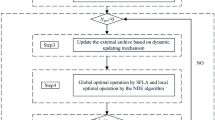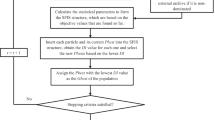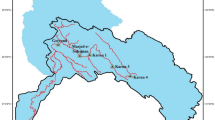Abstract
With the increasing power demand and rapid depletion of conventional fossil fuel resources, hydroelectric power resource has caused great attention of the public. A multi reservoir system with multiple objectives including ecological water demand, hydropower generation, and water diversion in Lushui River basin in China is under consideration in this context. Aiming to improve the efficiency of the water resources utilization, a novel method called multi-objective Moth-flame optimization algorithm (MOMFA) has been applied into this problem. The proposed algorithm involves the effective properties of the original Moth-flame optimization algorithm and two efficient mechanisms named opposition-based learning and indicator-based selection have also been integrated into the algorithm with the purpose of assisting the algorithm to accelerate the convergence and maintain the diversity simultaneously. The performance of the proposed MOMFA tested on a series of benchmarks and the Lushui River Basin. The result indicated that the proposed algorithm is not only capable of obtaining the well pareto solutions on standard problem but also can find the best tradeoff of the components and simultaneously achieve a set of well distributed non-dominated solutions for the multi-objective water resources utilization problem. Compare with the results obtained by other algorithms, the superiority of the proposed MOMFA has also been verified.



Similar content being viewed by others
References
Aboutalebi M, Bozorg-Haddad O, Loáiciga HA (2016) Multiobjective design of water-quality monitoring networks in river-reservoir systems. J Environ Eng 143(1):04016,070
Afshar M (2012) Large scale reservoir operation by constrained particle swarm optimization algorithms. J Hydro Environ Res 6(1):75–87
Ahmad A, El-Shafie A, Razali SFM, Mohamad ZS (2014) Reservoir optimization in water resources: a review. Water Resour Manag 28(11):3391–3405
Ashtiani EF, Niksokhan MH, Ardestani M (2015) Multi-objective waste load allocation in river system by mopso algorithm. Int J Environ Res Public Health 9(1):69–76
Bai T, Jx Chang, Chang FJ, Huang Q, Ym Wang, Gs Chen (2015) Synergistic gains from the multi-objective optimal operation of cascade reservoirs in the upper yellow river basin. J Hydrol 523:758–767
Ballester PJ, Carter JN (2007) Model calibration of a real petroleum reservoir using a parallel real-coded genetic algorithm. In: IEEE Congress on evolutionary computation, 2007. CEC 2007, IEEE, pp 4313–4320
Bozorg-Haddad O, Karimirad I, Seifollahi-Aghmiuni S, Loáiciga HA (2014) Development and application of the bat algorithm for optimizing the operation of reservoir systems. J Water Resour Plan Manag 141(8):04014,097
Chang J, Meng X, Wang ZZ, Wang X, Huang Q (2014) Optimized cascade reservoir operation considering ice flood control and power generation. J Hydrol 519:1042–1051
Deb K, Agrawal S, Pratap A (2000) Meyarivan t. Springer, Berlin
Deb K, Pratap A, Agarwal S, Meyarivan T (2002) A fast and elitist multiobjective genetic algorithm: Nsga-ii. IEEE Trans Evol Comput 6(2):182–197
Eberhart RC, Kennedy J et al (1995) A new optimizer using particle swarm theory. In: Proceedings of the sixth international symposium on micro machine and human science, New York, vol 1, pp 39–43
Fu X, Li A, Wang L, Ji C (2011) Short-term scheduling of cascade reservoirs using an immune algorithm-based particle swarm optimization. Computers & Mathematics with Applications 62(6):2463– 2471
Haddad OB, Moravej M, Loáiciga HA (2014) Application of the water cycle algorithm to the optimal operation of reservoir systems. J Irrig Drain Eng 141(5):04014,064
He Y, Xu Q, Yang S, Liao L (2014) Reservoir flood control operation based on chaotic particle swarm optimization algorithm. Appl Math Model 38(17–18):4480–4492
Hejazi MI, Cai X (2011) Building more realistic reservoir optimization models using data mining–a case study of shelbyville reservoir. Adv Water Resour 34(6):701–717
Knowles J, Corne D (1999) The pareto archived evolution strategy: a new baseline algorithm for pareto multiobjective optimisation. In: Proceedings of the 1999 congress on evolutionary computation, 1999. CEC 99, vol 1, IEEE
Lai C, Shao Q, Chen X, Wang Z, Zhou X, Yang B, Zhang L (2016) Flood risk zoning using a rule mining based on ant colony algorithm. J Hydrol 542:268–280
Liu P, Li L, Guo S, Xiong L, Zhang W, Zhang J, Xu CY (2015) Optimal design of seasonal flood limited water levels and its application for the three gorges reservoir. J Hydrol 527:1045–1053
Loucks DP, Stedinger JR, Haith DA et al (1981) Water resource systems planning and analysis. Prentice-Hall
Mirjalili S (2015) Moth-flame optimization algorithm: a novel nature-inspired heuristic paradigm. Knowl-Based Syst 89:228–249
Pérez CJ, Vega-Rodríguez MA, Reder K, Flörke M (2017) A Multi-Objective Artificial Bee Colony-based optimization approach to design water quality monitoring networks in river basins. J Clean Prod 166:579–589
Rahnamayan S, Tizhoosh HR, Salama MMA (2008) Opposition-based differential evolution. IEEE Trans Evol Comput 12(1):64–79
Reddy MJ, Kumar DN (2007) Multiobjective differential evolution with application to reservoir system optimization. J Comput Civ Eng 21(2):136–146
Schott JR (1995) Fault tolerant design using single and multicriteria genetic algorithm optimization. Tech. rep., DTIC Document
Sierra MR, Coello CAC (2005) Improving pso-based multi-objective optimization using crowding, mutation and-dominance. In: Evolutionary multi-criterion optimization, Springer, pp 505–519
Srinivas N, Deb K (1994) Multiobjective function optimization using nondominated sorting genetic algorithms. IEEE Trans Evol Comput 2(3):1301–1308
Tayebiyan A, Ali TAM, Ghazali AH, Malek M (2016) Optimization of exclusive release policies for hydropower reservoir operation by using genetic algorithm. Water Resour Manag 30(3):1203–1216
Van Veldhuizen DA, Lamont GB (1998) Multiobjective evolutionary algorithm research: a history and analysis. Tech. rep., Citeseer
Wagner M, Neumann F (2013) A fast approximation-guided evolutionary multi-objective algorithm. In: Conference on genetic and evolutionary computation, pp 687–694
Walker WE, Loucks DP, Carr G (2015) Social responses to water management decisions. Environ Prog 2(3):485–509
Wolpert DH, Macready WG (1997) No free lunch theorems for optimization. IEEE Trans Evol Comput 1(1):67–82
Zitzler E (2008) Evolutionary algorithms for multiobjective optimization: methods and applications. Science & Technology Information 4(2):59–68
Zitzler E, Künzli S (2004) Indicator-based selection in multiobjective search. Lect Notes Comput Sci 3242:832–842
Zitzler E, Laumanns M, Thiele L (2001) Spea2: Improving the strength pareto evolutionary algorithm
Acknowledgements
Thanks for the data supporting of the water resources department of the Ji’an, Jiangxi Province in China and the great help of the Hangzhou Regional Center(Asia-Pacific)for Small Hydro Power(HRC). Furthermore, This work was supported by grants from the National Science & Technology Pillar Program during the 12th Five-year Plan Period (Grant No. 2012BAD10B01), National Natural Science Foundation (Grant No. 61379123), National Natural Science Foundation (Grant No. 61572438) and The Open Found of The Key Laboratory for Metallurgical Equipment and Control of Ministry of education in Wuhan University of Science and Technology.
Author information
Authors and Affiliations
Corresponding author
Rights and permissions
About this article
Cite this article
Li, W.K., Wang, W.L. & Li, L. Optimization of Water Resources Utilization by Multi-Objective Moth-Flame Algorithm. Water Resour Manage 32, 3303–3316 (2018). https://doi.org/10.1007/s11269-018-1992-7
Received:
Accepted:
Published:
Issue Date:
DOI: https://doi.org/10.1007/s11269-018-1992-7




